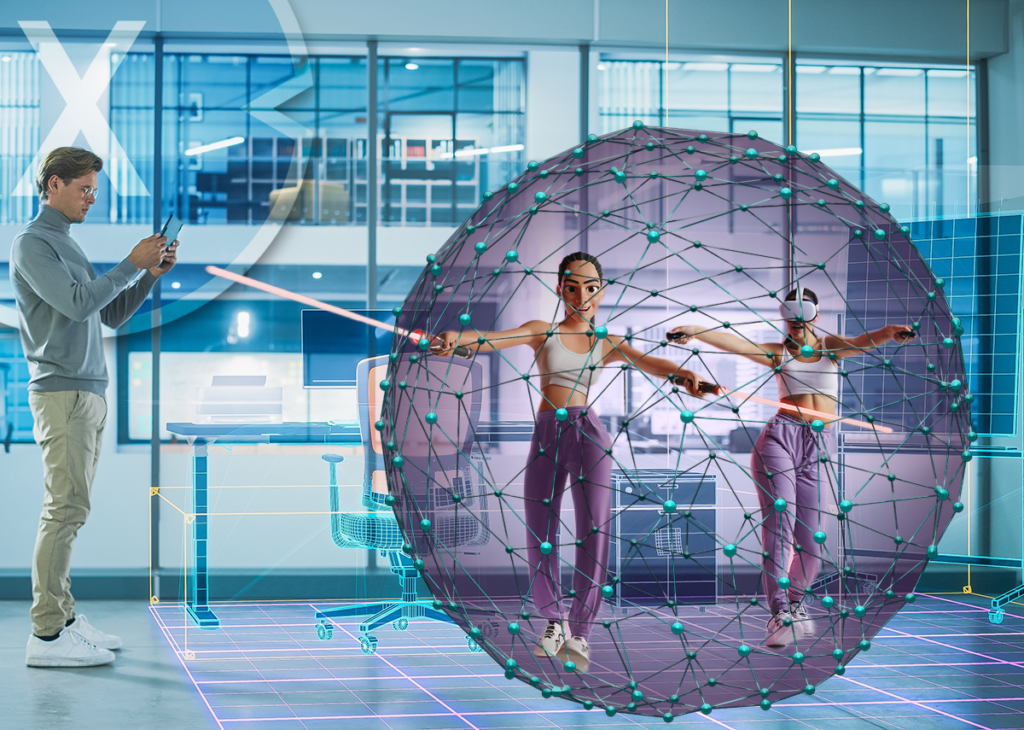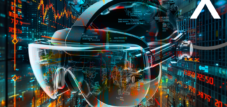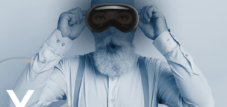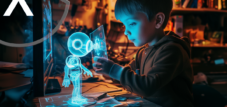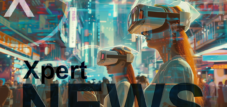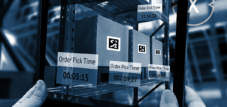What can spatial computing be confused with and what are the far-reaching consequences associated with augmented reality and the use of AI?
Language selection 📢
Published on: September 4th, 2024 / Update from: September 4th, 2024 - Author: Konrad Wolfenstein

What can spatial computing be confused with and what are the far-reaching consequences associated with augmented reality and the use of AI? – Image: Xpert.Digital
🌐 Spatial computing can be confused with various concepts that also use technologies to collect, interact and process data in space
🌐 The most common mix-ups include:
1. Virtual Reality (VR)
VR refers to completely virtual environments that users can immerse themselves in through VR glasses. However, spatial computing includes not only virtual worlds, but also real environments that are augmented by digital elements.
2. Augmented Reality (AR)
AR overlays digital information over the real world, similar to spatial computing, but AR is often limited to visual additions. Spatial computing, on the other hand, also includes other sensory inputs (such as haptics and movement) and interactions.
3. Mixed Reality (MR)
This term describes an extended form of AR in which digital and physical objects interact in real time. Spatial computing could be seen as an advanced form of MR because it captures the entire environment and enables seamless interaction with virtual and physical objects.
4. 3D computing
This refers to technologies that work with three-dimensional models, but do not necessarily operate in or take into account the physical world, as spatial computing does.
5. Geospatial computing
This concept focuses on geographical data and the analysis of information with a spatial reference, for example through maps or satellite images. Spatial computing, on the other hand, encompasses broader interactive and immersive applications.
🏷️ Related terms and their differences: Provide clarity
These terms are all related but have different focuses, which can lead to confusion.
📣 Similar topics
- 🚚 Revolution in global logistics: Blockchain and digital twins
- 🔗 Blockchain in Global Logistics: An Overview
- 🌍 Blockchain and Digital Twins: A perfect synergy for logistics
- 🛠️ What is blockchain and how does it work?
- 🏆 Benefits of Blockchain in the Global Supply Chain
- 🧠 What is a digital twin and how does it simplify logistics?
- 🚛 Digital Twins and Blockchain: The Future of Global Logistics
- 📈 Efficiency, transparency and security through blockchain
- ⚙️ Challenges and future prospects for blockchain and digital twins
- 💡 Opportunities to improve global logistics
#️⃣ Hashtags: #DigitaleLogistik #Blockchain #DigitalTwin #Efficiency #Transparency
🗒️ Xpert.Digital: A pioneer in the field of extended and augmented reality
🌍✨ Spatial Computing: Merging the physical and digital worlds
🌐🤖 Spatial computing is a broad concept that describes the way digital information can be integrated and manipulated in the physical world. It is an evolution of computer science in which physical and digital worlds are increasingly merging to create interactive and immersive experiences. The core idea behind spatial computing is to place digital content in a three-dimensional environment and manipulate it in real time.
❓🔧 How does spatial computing work?
Spatial computing builds on technologies such as sensors, cameras, computer vision, machine learning and artificial intelligence (AI). These components enable computers to “understand” the physical world and to interact with it. Physical objects and rooms are recorded, analyzed and translated into digital environments. A prominent example of this are headsets such as Microsoft's Hololens or the Magic Leap One, the Augmented Reality (AR) use to project virtual objects into the real world.
🕶️🌐 Augmented and Extended Reality
Augmented Reality (AR) and Extended Reality (XR) play a central role in the field of spatial computing. AR extends the real world with digital content. This often happens via smartphones or special glasses that enable the user to see additional information or interactive elements in your area. An example of AR is the “Pokémon Go” app, in which virtual Pokémon are embedded in the real world.
Extended Reality (XR) is an umbrella term that includes both augmented reality and virtual reality (VR) and mixed reality (MR). While AR blends digital elements into the real world, VR goes one step further by fully immersing the user in a computer-generated environment. Mixed Reality (MR) combines these two approaches by creating virtual objects that interact with the real world.
🧠💡 The connection between spatial computing and AI
Artificial intelligence (AI) is an essential part of spatial computing because it enables systems to interpret and respond to the real world in real time. This can be done through various AI approaches such as: B. through machine learning, which helps computers recognize and learn from patterns in the physical world. For example, AI can track the movements of objects and people, analyze their surroundings and draw meaningful conclusions from them.
An example of the application of AI in conjunction with spatial computing is facial recognition. In many AR and VR systems, AI makes it possible to recognize faces and even interpret emotional states. These technologies are increasingly being used in areas such as security, healthcare and entertainment.
🌟🏥 Wide-ranging consequences and applications
The possible uses of spatial computing are almost limitless. In medicine, spatial computing could help surgeons perform more precise operations by using AR applications to project important information directly into their field of vision. Education could create immersive learning environments where students can better understand complicated concepts through interactive visualizations.
Spatial computing also opens up new possibilities in industry. Manufacturing facilities could be monitored and optimized through digital twins – virtual copies of physical objects or systems. This leads to more efficient processes, less downtime and better planning of maintenance work.
Another exciting development is the integration of spatial computing into the field of entertainment. AR and VR applications enable completely new ways of experiencing films, games and other media. For example, viewers could immerse themselves directly in the action of a film or enjoy interactive experiences in theme parks.
⚖️🚨 Challenges and ethical questions
Despite the numerous advantages and possibilities, spatial computing also brings with it challenges. One of the biggest hurdles is protecting privacy. Because spatial computing often relies on extensive data collection - including the collection of environmental data, personal information and even biometric data - there is a risk of misuse of this data. Strict policies and safeguards must therefore be established to ensure that data is used responsibly.
Another ethical challenge is the potential loss of jobs due to the automation that spatial computing can bring. In many industries, the need for human labor could be reduced through the use of AI and automated systems. This raises questions about the future of work and social justice.
The question of control over digital content in the physical world is also relevant. As digital and physical worlds increasingly merge, it may become difficult to distinguish the line between reality and fiction. This could cause problems when it comes to separating fake information or manipulated content from the real world.
📜🔮 The combination with spatial computing
Spatial computing has the potential to revolutionize numerous industries and fundamentally change the way we live and work. By combining artificial intelligence, augmented reality, virtual reality and other technologies, the physical world is merging with the digital world, offering endless opportunities for innovation.
The impact of this technology on society, the economy and ethics is far-reaching and will need to be discussed more intensively in the coming years. It remains to be seen how these technologies will be further developed and implemented and what measures will be taken to address their ethical and social implications. But one thing is certain: spatial computing will play a central role in the future of human-technology interaction.
📣 Similar topics
- 🌐 The future of human-technology interaction
- 🔍 How does spatial computing work?
- 🥽 Augmented and Extended Reality explained
- 🤖 The connection between spatial computing and AI
- 🌍 Far-reaching consequences and applications of spatial computing
- ⚖️ Challenges and ethical issues in spatial computing
- 🧠 Innovative technologies: AR, VR and XR
- 🏥 Applications of spatial computing in medicine
- 🎓 Education and 3D learning environments
- 🎮 Entertainment and immersive experiences
#️⃣ Hashtags: #SpatialComputing #AugmentedReality #ArtificialIntelligence #DigitalTransformation #EthicalIssues
Our recommendation: 🌍 Limitless reach 🔗 Networked 🌐 Multilingual 💪 Strong sales: 💡 Authentic with strategy 🚀 Innovation meets 🧠 Intuition
At a time when a company's digital presence determines its success, the challenge is how to make this presence authentic, individual and far-reaching. Xpert.Digital offers an innovative solution that positions itself as an intersection between an industry hub, a blog and a brand ambassador. It combines the advantages of communication and sales channels in a single platform and enables publication in 18 different languages. The cooperation with partner portals and the possibility of publishing articles on Google News and a press distribution list with around 8,000 journalists and readers maximize the reach and visibility of the content. This represents an essential factor in external sales & marketing (SMarketing).
More about it here:
🌌 Spatial Computing: The Fusion of Digital and Physical
🌐🔗 Spatial computing is an emerging technology that connects the digital and physical worlds, enabling interaction with data and objects in a three-dimensional space. This technology uses a combination of artificial intelligence (AI), augmented reality (AR), virtual reality (VR), sensing and advanced hardware solutions to enable a more comprehensive understanding and deeper integration of digital and physical environments.
The possible uses of spatial computing are diverse and far-reaching, as it plays an important role in numerous industries and applications. Below are some of the key areas and use cases where spatial computing is being used today and in the future.
1. 🎓 Education and training
Spatial computing has the potential to fundamentally transform learning by creating immersive and interactive learning environments. In classrooms, students can interact with 3D digital models, visualize complex concepts, and learn in simulated environments. For example, medical students can view anatomical models in 3D and perform surgeries virtually to improve their practical skills. Such simulations provide a safe environment in which mistakes can be made and learned from without real risks.
2. 🏥 Healthcare
Spatial computing already plays a crucial role in healthcare, particularly in the areas of surgery and medical imaging. Surgeons can use AR and VR technologies to plan precise surgical procedures using detailed 3D models of patient organs and tissues. This technology allows doctors to gain a better overview of the patient's anatomy, resulting in more precise and less invasive procedures. In addition, by using spatial computing in rehabilitation, virtual therapies can be developed to help patients recover.
3. 🏠 Real Estate and Architecture
Another important area where spatial computing is applied is the real estate industry. Architects and civil engineers can use 3D visualizations and AR models to view buildings in real time and simulate their designs in the real world. This allows them to identify potential problems early and adjust their plans accordingly. Homebuyers can also take virtual tours of properties before they are even built. This saves time and resources and improves decision making for both builders and buyers.
4. 🎮 Entertainment and Gaming
In the entertainment sector, especially in the gaming industry, spatial computing has sparked a revolution. By integrating VR and AR, players can fully immerse themselves in virtual worlds and interact with their surroundings in ways that were previously unimaginable. Games like Pokémon Go have shown how AR can be used to merge the physical world with the digital. Future games could become even more immersive by incorporating players' real-world surroundings into gameplay, creating personalized gaming experiences.
5. 🏭 Industry and Manufacturing
Spatial computing is used in industry to optimize production processes and make work processes more efficient. In manufacturing plants, workers can use AR glasses to receive real-time information about machines, production lines and work instructions without having to take their eyes off their work. This increases productivity and reduces the margin of error. Maintenance and repair work also benefits from spatial computing, as technicians are guided step by step through complex repair processes using AR instructions.
6. 🛍️ Trade and e-commerce
In retail, spatial computing offers new opportunities to improve the customer experience. AR technology allows customers to virtually project products into their own environment and see how furniture or clothing would look in their home or on their body before making a purchase. This leads to higher customer satisfaction and reduces the number of returns. Companies also use this technology to create interactive and personalized shopping experiences that strengthen customer loyalty to the brand.
7. 🌆 Urban planning and transport
Spatial computing can also be used in urban planning and traffic management. City planners can use 3D models to visualize cities and plan future developments. This helps them better understand the impact of construction projects on the surrounding area and make informed decisions. In the transportation sector, the use of AR technologies in vehicles can provide drivers with real-time information about their surroundings, such as navigation instructions, hazard warnings and traffic information. These technologies help increase traffic safety and reduce traffic jams.
8. 🌾 Agriculture
In agriculture, spatial computing can help farmers manage their fields more efficiently. By combining sensors, drones and AR technology, farmers can receive real-time information about the condition of their fields, such as soil moisture content or crop maturity. This allows for precise management and reduces the use of water, fertilizers and pesticides, both increasing yields and reducing environmental impact.
9. 🎨 Art and Design
Artists and designers use spatial computing to explore new creative expressions. By creating 3D models and using AR, artists can take their works to new dimensions and create immersive art experiences. AR and VR technologies are also used in fashion and interior design to simulate and adapt design concepts in the real world before they are physically implemented.
10. 🛡️ Military and Defense
In the military sector, spatial computing is used to improve training and support missions. Soldiers can train in virtual environments that simulate real combat scenarios without any risk. Spatial computing can also be used in real-world operations to provide soldiers with real-time information about their surroundings, for example through AR displays in helmets that provide information about terrain, enemy movements and navigation routes.
🚀 A transformative technology
Spatial computing is a transformative technology that can be applied to almost all areas of our lives. From education to health to industry and entertainment, there are numerous opportunities to improve the way we interact with the world. As technology continues to advance, it is likely that we will see even more innovative use cases in the future that revolutionize our daily lives and the way we work.
📣 Similar topics
- 📚 Education and training rethought
- 🧑⚕️ Surgery and rehab revolution
- 🏠 Real estate visions of the future
- 🎮 Immersive gaming experiences
- 🏭 Industrial production optimization
- 🛒 Revolution in retail
- 🏙️ Urban development and smart traffic
- 🌾 Agriculture 4.0 with digital help
- 🎨 Awaken creative potential
- 🛡️ Increased military efficiency
#️⃣ Hashtags: #SpaceComputing #VRandAR #DigitalTransformation #IndustrialApplications #InteractiveTechnology
We are there for you - advice - planning - implementation - project management
Xpert.Digital - Pioneer Business Development
Smart Glasses & KI - XR/AR/VR/MR industry expert
Consumer metaverse or meta -verse in general
If you have any questions, further information and advice, please feel free to contact me at any time.
I would be happy to serve as your personal advisor.
You can contact me by filling out the contact form below or simply call me on +49 89 89 674 804 (Munich) .
I'm looking forward to our joint project.
Xpert.Digital - Konrad Wolfenstein
Xpert.Digital is a hub for industry with a focus on digitalization, mechanical engineering, logistics/intralogistics and photovoltaics.
With our 360° business development solution, we support well-known companies from new business to after sales.
Market intelligence, smarketing, marketing automation, content development, PR, mail campaigns, personalized social media and lead nurturing are part of our digital tools.
You can find out more at: www.xpert.digital - www.xpert.solar - www.xpert.plus



